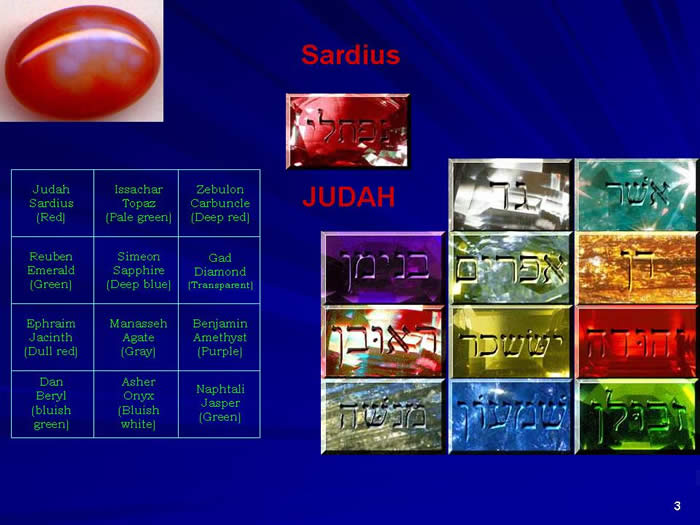
2009 Holy Land Tour - Turkey
Part 8 - Sardis
Click on Photos, Charts and Maps for Larger Version
For the past several weeks, I have been telling you about our recent trip to the nation of Turkey. Last week, our guide, Seyhun, had some “candy” to give us that day. “Candy” means he takes us to a place not on our itinerary – something extra.
We pulled off the highway toward the mountains, and drove through the small city of Alaşehir – with a population of almost 50,000. Alaşehir is the modern name of the ancient city of Philadelphia.
SARDIS
Sardis (sometimes spelled Sardes), modern Sart, is in the Manisa province of Turkey. The name Sardis is that of the stone, sardius (Greek: sardinos) as mentioned in Revelation 4:3, or called Carnelian is some translations. The semi-precious stone is orange-brown but reflects deep red when light is passed through it.
The Sardius is mentioned in the Bible in several other settings. We know it was one of the 12 precious and semi-precious stones in high priest’s breastplate. You can read of each stone in the instructions given by God to make the breastplate. There are at least two list of the 12 stones – Exodus 28:17 and Exodus 39:10. The Sardius is the upper-left stone – and represents the tribe of Judah.
The stones in the breastplate of the High Priest are also described in the book of Revelation as making up the 12 foundation stones of the New Jerusalem. Sardius is also used to describe the color surrounding the throne of God in Revelation 4:3.
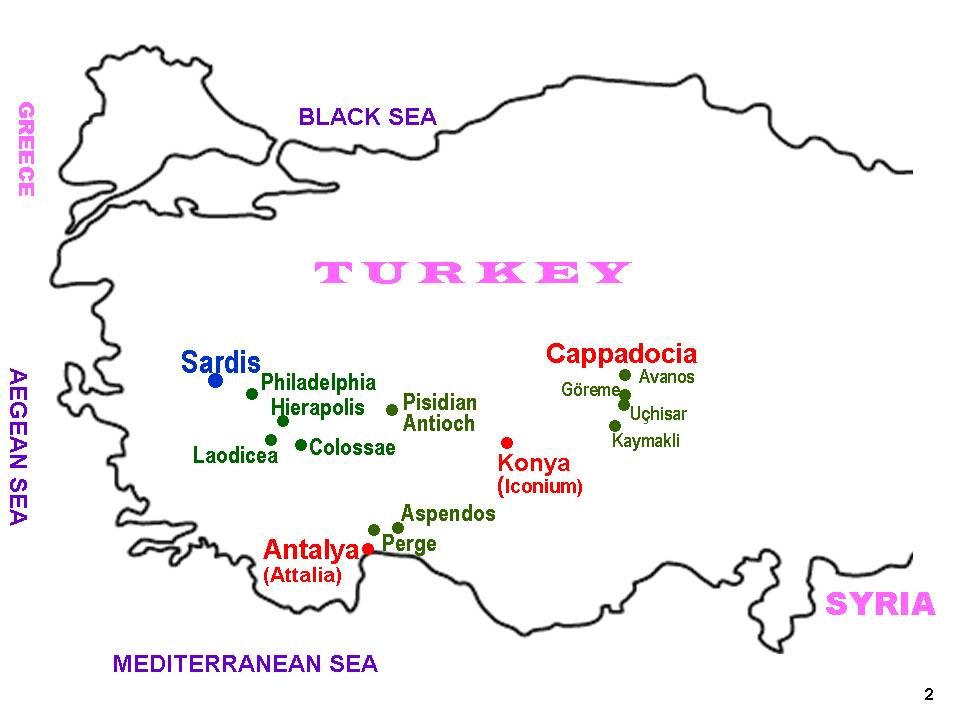 In ancient times Sardis was the capital of the Lydian Empire, and an important city during the time of Persian control. Under the Roman Empire, it was the seat of the proconsul. Sardis is 30 miles southeast of Thyatira and 45 miles east of Izmir (Smyrna) [See map at left]. At the time of the apostle John, its population is estimated at 120,000.
In ancient times Sardis was the capital of the Lydian Empire, and an important city during the time of Persian control. Under the Roman Empire, it was the seat of the proconsul. Sardis is 30 miles southeast of Thyatira and 45 miles east of Izmir (Smyrna) [See map at left]. At the time of the apostle John, its population is estimated at 120,000.
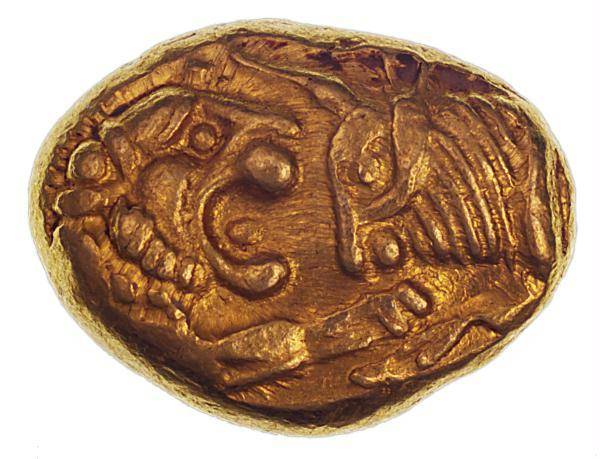
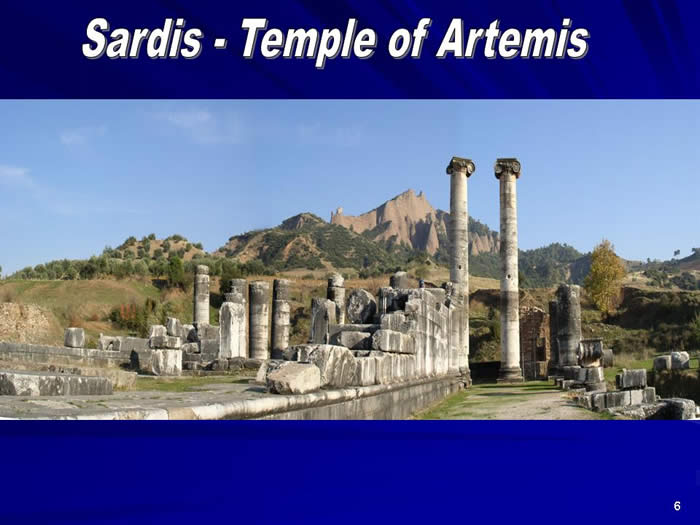 Photo at right shows Sardis located in the middle of the Hermus Valley, at the foot of Mount Tmolus, on which was located the citadel or acropolis, some 1,100 feet above the valley. Evidence has been unearthed showing this city to be one of the oldest in Asia Minor.
Photo at right shows Sardis located in the middle of the Hermus Valley, at the foot of Mount Tmolus, on which was located the citadel or acropolis, some 1,100 feet above the valley. Evidence has been unearthed showing this city to be one of the oldest in Asia Minor.
The last and most famous of the Lydian kings, Croesus (560-546 B.C.) was said to have panned gold out of the nearby Pactolus River. He was the first to ever mint coins – some of silver and others of gold.
When Croesus was king, Sardis fell to Cyrus, the Persian king. This is the same Cyrus who defeated the Belshazzar and the Babylonians in 538 B.C. As a point of trivia, Cyrus was one of 7 people named before they were born. The other six were: Ishmael, Isaac, Solomon, Josiah, John the Baptist and Jesus. In the case of Cyrus, Isaiah 44:28 & 45:1 prophecy concerning him almost 200 years before his birth.
At right is a map showing the kingdom of Cyrus the Great. As you look at the upper left of this map, you see that when he was victorious at his battle with Croeses at Sardis, he had conquered all of what is Turkey today except Cilicia.
The historian, Herodotus, who lived in the 5th century before Christ, and who is sometimes called the father of history in Western culture, says, “their defeat literally shocked the Lydians. They considered their city – at least its acropolis – to be impregnable.”
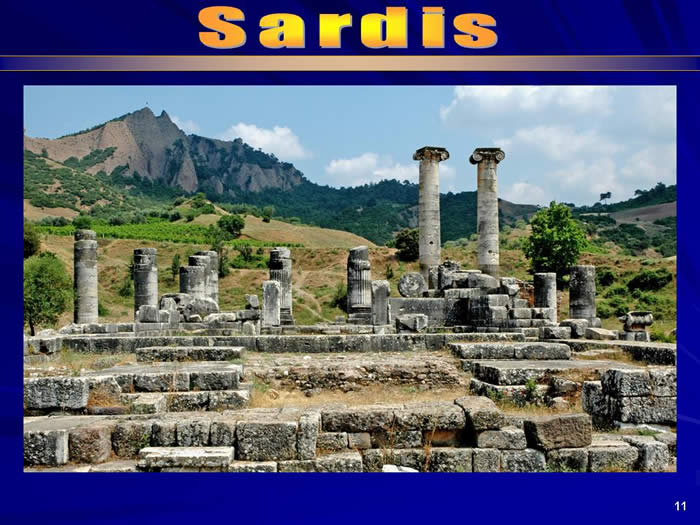
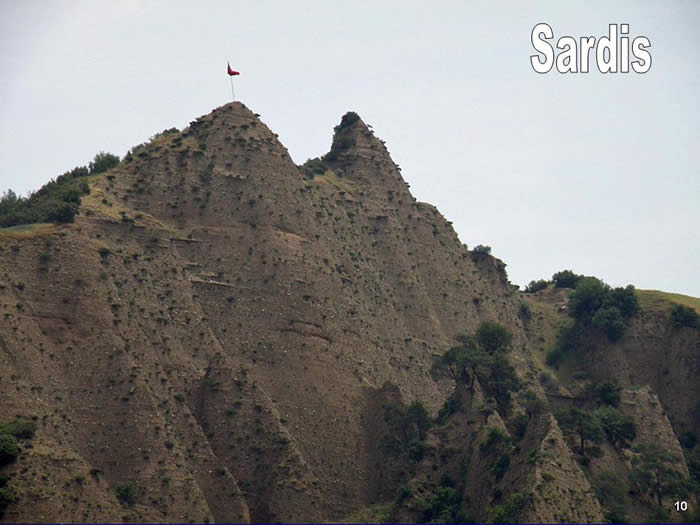 Photos at left are of the Acropolis taken from the temple of Artemis. As mentioned earlier, the acropolis is about 1,100 feet above the valley, surrounded by what seemed to be sheer cliffs. According to Herodotus, the Persian forces were in the valley below the citadel, trying to figure a way to the top.
Photos at left are of the Acropolis taken from the temple of Artemis. As mentioned earlier, the acropolis is about 1,100 feet above the valley, surrounded by what seemed to be sheer cliffs. According to Herodotus, the Persian forces were in the valley below the citadel, trying to figure a way to the top.
They figured there must be a way, since the people atop the cliffs got there somehow. And as they were examining the lower slopes, one of Cyrus’ soldiers noticed a Lydian soldier far above him lean over and lose his helmet down the cliff. The Persian saw the Lydian soldier as he scaled down the rock precipice to retrieve his helmet. He tells his commander, King Cyrus, and when the opportunity came, they used that information to scale and take the citadel.
A couple of centuries later, the Persians are defeated by Alexander the Great in 334 B.C. After the death of Alexander, and his kingdom divided into four kingdoms, the Seleucid kingdom made Sardis their western administrative center. One later notable battle occurred in 214 B.C., when the city fell to Antiochus the Great using the same tactics as the Persian.
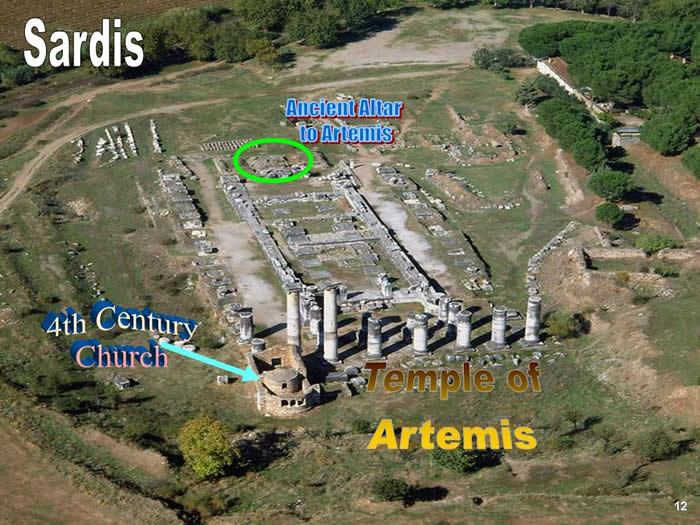 The Temple of Artemis was a massive structure, the seventh largest of all Greek temples, twice the size of the Parthenon in Athens. The goddess Artemis is known as Diana by the Romans, the name she is called in the 19th chapter of Acts (in the KJV, NKJV and ASV). We will talk more about Artemis in Ephesus, where an even larger temple to her was built.
The Temple of Artemis was a massive structure, the seventh largest of all Greek temples, twice the size of the Parthenon in Athens. The goddess Artemis is known as Diana by the Romans, the name she is called in the 19th chapter of Acts (in the KJV, NKJV and ASV). We will talk more about Artemis in Ephesus, where an even larger temple to her was built.
The original temple was probably what is called a Dipteros. That means it was a temple with two rows of columns around an enclosed inner section. Just outside the entrance – on the west side – you will find an altar of Artemis which is actually much older than the temple.
In the photo at right, you will notice a separate brownish structure at the lower left of the Temple, just below the two highest columns. It is a 4th century church, where Christians worshiped long after the worship of Artemis had ceased. The photos to the left are close-ups of the church.
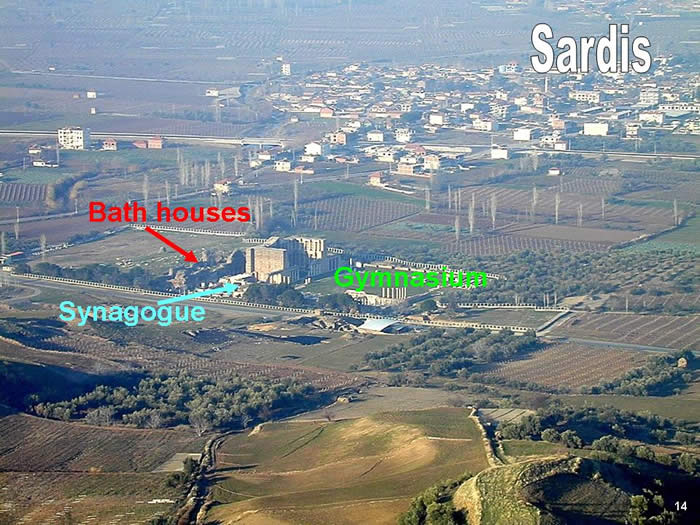
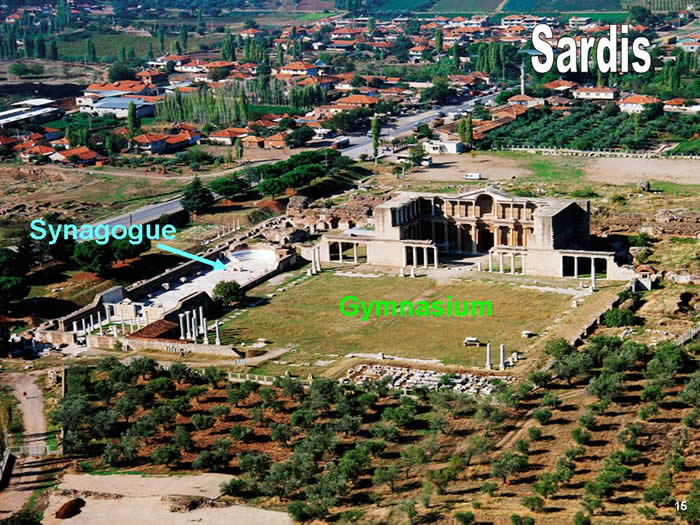 Less than a mile away, you will see two more ancient buildings. One is a Jewish Synagogue on the left in this photo, and the other is the restored façade of an ancient gymnasium. In ancient times this would have been in the center of the city. The large bath-gymnasium complex covered five acres. Behind the gymnasium is a couple of bath houses, something you find in all Roman cities of antiquity.
Less than a mile away, you will see two more ancient buildings. One is a Jewish Synagogue on the left in this photo, and the other is the restored façade of an ancient gymnasium. In ancient times this would have been in the center of the city. The large bath-gymnasium complex covered five acres. Behind the gymnasium is a couple of bath houses, something you find in all Roman cities of antiquity.
At right is another aerial view of the complex. The synagogue wasn’t discovered and unearthed until 1962, and is one of the most significant monuments of Jewish Diaspora in Roman Asia Minor. In size it is one of the largest synagogues ever excavated in the ancient world. And to be located in the center of the ancient city speaks to a large Jewish influence in Sardis.
In ancient Sardis, Jews held seats on the city council and important offices in the Roman civil administration. Much of the funding for restoration of this synagogue came from American Jewish individuals.
The photo at left shows the modern road atop the rise just to the left of the ruins. The ancient street level was some 11-12 feet below the modern street level. The man in the photo is walking on the pedestrian walkway between the shops and ancient “Marble Way,” which ran parallel to the modern street. On the other side of the wall to the right is the ancient synagogue. This was the main street and was lined with shops, many of which were owned by Jewish merchants and artisans. Before moving on, notice the terracotta pipe on the right. I will show you a couple more photos with pipes.
In its day, Marble Way was a rather wide street though most of it has not be uncovered. At far left is a photo of the area where they have excavated the width of the street down to the old street level. The street was lined with columns.
Notice again the terracotta pipes in the photo at right, which shows they had running water. Also notice they have been able to identify whose shop it belonged to. The sign says, “Shop of Jacob, Elder of the Synagogue.” Most of the signs on these shops show them to have belonged to Jews.
The synagogue itself is of grand proportions. It had some incredible inlaid mosaic floors and colored stone wall decorations were also often made of inlaid stones. It is also important for the more than eighty inscriptions that have been found in its interior. With the exception of six fragments in Hebrew, the inscriptions are in Greek.
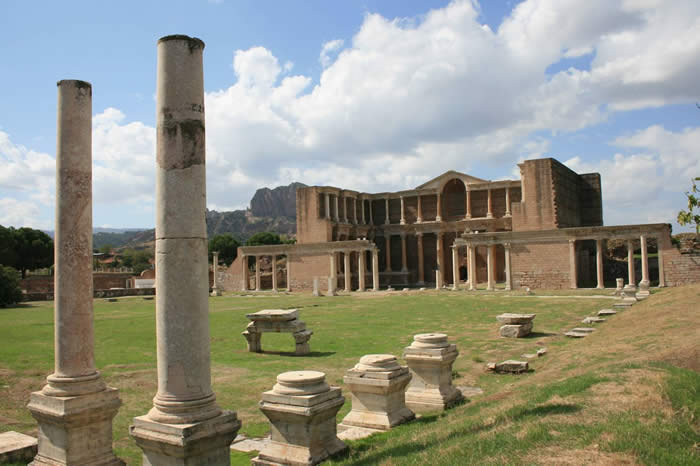
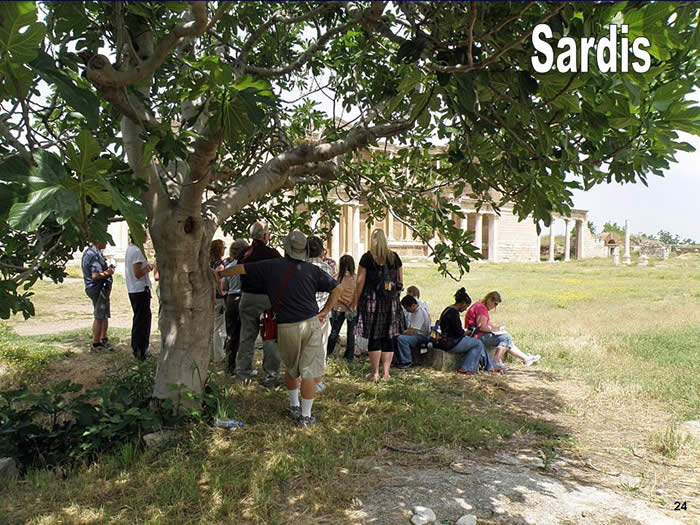
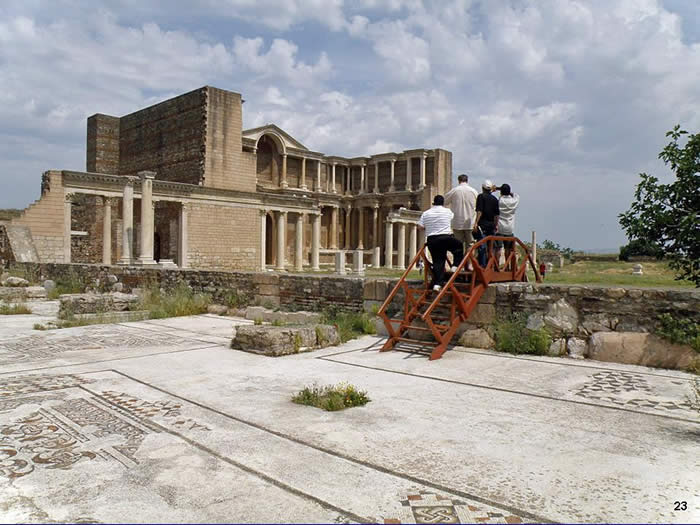 Next to the synagogue is a restored façade of an ancient gymnasium. We use a small bridge to cross over the stone fence into the Gymnasium’s field. We take a breather from the heat of the day as our guide tells us about this place.
Next to the synagogue is a restored façade of an ancient gymnasium. We use a small bridge to cross over the stone fence into the Gymnasium’s field. We take a breather from the heat of the day as our guide tells us about this place.
The area of the synagogue probably was, at an earlier time, part of the Gymnasium complex. There was a wing on the opposite side of the Gymnasium that, with the area occupied by the synagogue, would have given the Bath-Gymnasium complex a symmetrical structure. Here is another angle of the Gymnasium façade. Around the top of this façade you find a lot of Greek writing.
Again, as I mentioned a few minutes ago, there were bath houses located behind the gymnasium. See photo at right
The only place where Sardis is mentioned in the Bible is as the fifth of the seven churches of Revelation, chapters 2 & 3. Earlier in our lesson, I mentioned that the letters to the seven churches in Revelation used a pattern that held consistent with the letters to all the churches.
Revelation 3:1-6 NKJV
1 "And to the angel of the church in Sardis write,
'These things says He who has the seven Spirits of God and the seven stars:
"I know your works, that you have a name that you are alive, but you are dead.
2 Be watchful, and strengthen the things which remain, that are ready to die,
for I have not found your works perfect before God.
3 Remember therefore how you have received and heard; hold fast and repent. Therefore if you will not watch, I will come upon you as a thief, and you will not know what hour I will come upon you.
4 You have a few names even in Sardis who have not defiled their garments; and they shall walk with Me in white, for they are worthy.
5 He who overcomes shall be clothed in white garments, and I will not blot out his name from the Book of Life; but I will confess his name before My Father and before His angels.
6 "He who has an ear, let him hear what the Spirit says to the churches."'
We need to still be listening to what the Holy Spirit has to say to the churches. The messages from Christ to the churches in Revelation are for us as well as them in the first century. Churches are people, and human nature has not changed. We must not look at these letters in Revelation as ancient relics. On the contrary, they are mirrors in which we see ourselves.